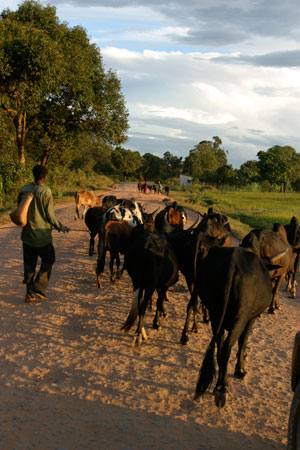Mosquitoes: The World's Deadliest Animals
Posted May 15, 2008 by Ali S. Khan

The area surrounding Antananarivo, Madagascar was not predicted to be a high risk area for Rift Valley Fever this year. Yet as I stepped off the plane from Italy last week, I reviewed a request from the MoH (Madagascar Ministry of Health) through their embassy for U.S. assistance as the epidemic that began in February continues to silently rage in the region.
Rift Valley Fever is spread by mosquitoes and mainly sickens cattle, sheep, goats, and camels. Occasionally people are also affected, and experience a range of symptoms from uncomplicated flu-like illness to hemorrhagic disease with severe liver involvement and eye or brain lesions. The biblical sickness has been historically found in regions of eastern and southern Africa where sheep and cattle are raised, but has also caused outbreaks in the sub-Sahara, and up through Saudi Arabia and Yemen. It tends to occur after lots of rain and hatching of infected mosquitoes ![]() FAO EMPRES (PDF – KB).
FAO EMPRES (PDF – KB).
We first got involved in the Madagascar outbreak in February when an increase in an unknown disease was noticed in cattle. Initial symptoms were thought to be caused by cowdriose, an animal disease spread by ticks, and the situation was believed to be under control after massive antibiotics treatment. Unfortunately, by April the disease had been correctly identified as Rift Valley, and the number of human fatalities was growing.
CDC responds to international outbreaks only when a request from the national authorities of that country is sent. But in such an event, actions are swift. Only hours later that day, a team of CDC scientists was already being scrambled to assist. Our team will join the mission to investigate the outbreak and evaluate field response efforts in support of the MoA (Ministry of Agriculture) and MoH in Madagascar.
RVF’s impact on the health of people can be fierce – and in addition – can lead to large economic loss for countries that rely heavily on livestock for income. The re-emergence of Rift Valley in Madagascar baffles current predictive models, and provides strong support for more ecological research on the disease. The rapid and unpredicted evolution of this outbreak, as well as the spread onto the Arabian Peninsula in recent years, is a reflection of the kind of battlefield we find ourselves immersed in each day. As scientists, doctors and veterinarians…we are also "fire-fighters", working on a very fluid and dynamic frontier.
Comments
No comments posted.
Disclaimer: The content of Public Health Matters expresses the opinions of its authors and does not necessarily represent the views of the Centers for Disease Control and Prevention.
- Page last reviewed: May 15, 2008
- Page last updated: May 15, 2008
- Content source: National Center for Zoonotic, Vector-Borne, and Enteric Diseases
Get email updates
To receive email updates about this page, enter your email address:
Contact Us:
- Centers for Disease Control and Prevention
1600 Clifton Rd
Atlanta, GA 30333 - 800-CDC-INFO
(800-232-4636)
TTY: (888) 232-6348
24 Hours/Every Day - cdcinfo@cdc.gov


